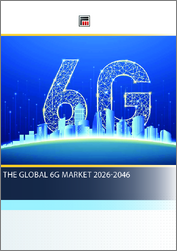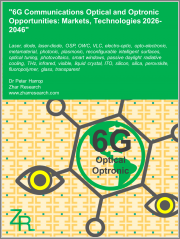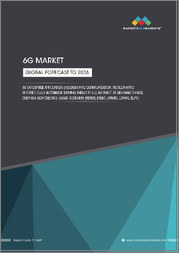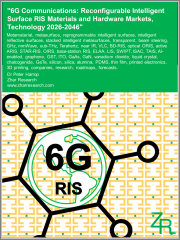
|
시장보고서
상품코드
1619078
세계의 6G 시장 : 규모, 점유율, 성장 분석, 용도별, 용도별, 통신별, 최종용도별, 지역별 산업 예측(2024-2031년)6g Market Size, Share, Growth Analysis, By Usage (Further-Enhanced Mobile Broadband, Extremely Low-Power Communications), By Application (Fully Automated Driving, Industry 5.0), By Communication, By End Use, By Region - Industry Forecast 2024-2031 |
||||||
6G 세계 시장 규모는 2022년 43억 달러로 평가되었고, 2023년 64억 달러에서 2031년 638억 달러로 성장하며 예측기간 중(2024-2031년) CAGR은 33.3%로 성장할 전망입니다.
6G 네트워크는 5G에 비해 100배의 에너지 효율과 체적 스펙트럼 효율을 제공함으로써 모바일 통신에 혁명을 일으킬 준비가 되었습니다. 특히 세계의 모바일 데이터 트래픽은 2020년부터 2030년에 걸쳐 매년 55% 급증하고 2030년에는 월간 5,016엑사바이트라는 놀라운 데이터량을 낳을 것으로 예측되고 있습니다. 이 엄청난 데이터 유입을 고급 처리 능력과 함께 활용함으로써 동적 네트워크 제어가 가능합니다. 사회의 요구와 기술의 진보에 힘입어 6G는 인텔리전스, 신뢰성, 확장성, 보안에 있어서 기존의 모바일 네트워크의 능력을 능가할 것으로 보입니다. 게다가 위성 통신을 통합함으로써 진정으로 세계적인 모바일 네트워크가 확립되어 세계의 접속성에 대한 요구 증가에 대응할 것으로 기대됩니다. 이 상황은 무선 기술에서 혁신의 큰 기회를 보여줍니다.
목차
소개
- 조사의 목적
- 조사 범위
- 정의
조사 방법
- 정보 조달
- 2차 데이터와 1차 데이터의 방법
- 시장 규모 예측
- 시장의 전제조건과 제한
주요 요약
- 세계 시장 전망
- 공급과 수요 동향 분석
- 부문별 기회 분석
시장 역학과 전망
- 시장 개요
- 시장 규모
- 시장 역학
- 성장 촉진요인과 기회
- 억제요인과 과제
- Porter's Five Forces 분석과 영향
- 경쟁 기업간 경쟁 관계
- 대체품의 위협
- 구매자의 협상력
- 신규 진입업자의 위협
- 공급기업의 협상력
주요 시장 인사이트
- 중요성공요인
- 경쟁도
- 주요 투자 기회
- 시장 생태계
- 시장의 매력 지수(2023년)
- PESTEL 분석
- 거시경제지표
- 밸류체인 분석
- 가격 분석
- 기술의 진보
- 규제 상황
- 사례 연구
- 특허 분석
6G 시장 규모 : 용도별 및 CAGR(2024-2031년)
- 시장 개요
- 확장 모바일 광대역 통신(FeMBB)
- 초고신뢰·저지연 통신(ERLLC)
- 장거리·고속 이동통신(LDHMC)
- 초대규모 기계형 통신(umMTC)
- 초저소비전력통신(ELPC)
6G 시장 규모 : 용도별 및 CAGR(2024-2031년)
- 시장 개요
- 홀로그램 통신
- 촉각 인터넷
- 완전자동운전
- 인더스트리 5.0
- 바이오나노모노의 인터넷
- 기타
6G 시장 규모 : 통신 및 CAGR(2024-2031년)
- 시장 개요
- 고정
- 셀룰러
- 광대역
6G 시장 규모 : 최종 용도별 및 CAGR(2024-2031년)
- 시장 개요
- 소비자
- 기업
- 제조업
- 헬스케어 및 생명과학
- 자동차
- 미디어 및 엔터테인먼트
- 항공우주 및 방어
- 기타
6G 시장 규모 및 CAGR(2024-2031년)
- 북미
- 미국
- 캐나다
- 유럽
- 영국
- 독일
- 스페인
- 프랑스
- 이탈리아
- 기타 유럽
- 아시아태평양
- 중국
- 인도
- 일본
- 한국
- 기타 아시아태평양
- 라틴아메리카
- 브라질
- 기타 라틴아메리카
- 중동 및 아프리카
- GCC 국가
- 남아프리카
- 기타 중동 및 아프리카
경쟁 정보
- 상위 5개사 비교
- 주요 기업의 시장 포지셔닝(2023년)
- 주요 시장 기업이 채용한 전략
- 시장의 최근 동향
- 기업의 시장 점유율 분석(2023년)
- 주요 기업의 기업 프로파일
- 기업 개요
- 제품 포트폴리오 분석
- 부문별 점유율 분석
- 수익의 전년대비 비교(2021-2023년)
주요 기업 프로파일
- Apple Inc.(United States)
- AT&T Inc.(United States)
- Cisco Systems, Inc.(United States)
- Ericsson AB(Sweden)
- Huawei Technologies Co., Ltd.(China)
- LG전자 주식회사(South Korea)
- Nokia Corporation(Finland)
- Orange SA(France)
- Qualcomm Incorporated(United States)
- Samsung Electronics Co., Ltd.(South Korea)
- SK Telecom Co., Ltd.(South Korea)
- Verizon Communications Inc.(United States)
- NTT DoCoMo, Inc.(Japan)
- Jio Platforms Limited(India)
- Bharti Airtel Limited(India)
- Vodafone Group Plc.(United Kingdom)
- Deutsche Telekom AG(Germany)
- China Mobile Limited(China)
- Telefonica SA(Spain)
- China Unicom (Hong Kong) Limited (Hong Kong)
결론과 권장사항
JHS 25.01.09Global 6g Market size was valued at USD 4.3 billion in 2022 and is poised to grow from USD 6.4 billion in 2023 to USD 63.8 billion by 2031, growing at a CAGR of 33.3% during the forecast period (2024-2031).
The 6G network is poised to revolutionize mobile communications by offering 100 times greater energy and volumetric spectral efficiency compared to 5G. This network's extensive interconnectivity poses unique challenges, particularly as global mobile data traffic is forecasted to surge 55% annually from 2020 to 2030, ultimately generating an astonishing 5,016 exabytes of data monthly by 2030. Leveraging this massive data influx alongside advanced processing capabilities will allow for dynamic network control. Driven by societal demands and technological progress, 6G will exceed existing mobile network capabilities in intelligence, reliability, scalability, and security. Furthermore, integrating satellite communication promises to establish a truly global mobile network, addressing the growing need for worldwide connectivity. This landscape illustrates significant opportunities for innovation in wireless technologies.
Top-down and bottom-up approaches were used to estimate and validate the size of the Global 6G market and to estimate the size of various other dependent submarkets. The research methodology used to estimate the market size includes the following details: The key players in the market were identified through secondary research, and their market shares in the respective regions were determined through primary and secondary research. This entire procedure includes the study of the annual and financial reports of the top market players and extensive interviews for key insights from industry leaders such as CEOs, VPs, directors, and marketing executives. All percentage shares split, and breakdowns were determined using secondary sources and verified through Primary sources. All possible parameters that affect the markets covered in this research study have been accounted for, viewed in extensive detail, verified through primary research, and analyzed to get the final quantitative and qualitative data.
Global 6G Market Segmental Analysis
Global 6g Market is segmented by Usage, Application, Communication, End Use Region. Based on Usage, the market is segmented into Further-Enhanced Mobile Broadband (FeMBB), Extremely Reliable, Low Latency Communications (ERLLC), Long-Distance and High-Mobility Communications (LDHMC), Ultra-Massive Machine Type Communications (umMTC), Extremely Low-Power Communications (ELPC). Based on Application, the market is segmented into Holographic Communications, Tactile/ Haptic Internet, Fully Automated Driving, Industry 5.0, Internet of Bio-nano-things, Other. Based on Communication, the market is segmented into Cellular, Broadband, Fixed. Based on End Use, the market is segmented into Consumers, Enterprises, (Manufacturing, Healthcare & life sciences, Automotive, Media & entertainment, Aerospace & defence, Others. Based on Region, the market is segmented into North America, Europe, Asia Pacific, Latin America and Middle East & Africa.
Driver of the Global 6G Market
The Global 6G market is primarily driven by the increasing demand for exceptionally fast and reliable connectivity, spurred by the worldwide surge in high-definition content streaming. As consumers and businesses alike seek seamless experiences, the urgency for ultra-high-speed networks has become paramount to enable advancements such as real-time communication, autonomous vehicles, and smart city infrastructure. 6G technology aims to meet this rising demand by offering unprecedented speeds and remarkably low latency, facilitating uninterrupted connectivity that not only transforms digital experiences but also propels market disruptions across various sectors. This evolution is vital for both consumers and businesses seeking enhanced connectivity solutions in an increasingly digital world.
Restraints in the Global 6G Market
Restraints in the Global 6G market are primarily attributed to the technological complexities involved in transitioning from existing wireless technologies to 6G. This transition requires the seamless integration of various advanced technologies such as innovative networking protocols, artificial intelligence, and machine learning. The intricate nature of these integrations may lead to significant development and deployment challenges for manufacturers and service providers. Consequently, these complications could restrict market growth over the long term, as delays in technology adoption and infrastructure development may hinder overall progress in the 6G landscape.
Market Trends of the Global 6G Market
The global 6G market is poised for significant growth as tech companies like Samsung unveil groundbreaking prototypes that revolutionize mobile networking. Innovations in signal processing and AI-driven analytics demonstrate the potential for enhanced network performance, setting the stage for future commercialization and deployment. This trend signals a competitive race among key players to establish leadership in the burgeoning 6G landscape, with anticipated advancements in speed, capacity, and connectivity. As stakeholders invest heavily in research and development, the market is expected to gain momentum, fostering collaboration across telecommunications, artificial intelligence, and other sectors, ultimately reshaping the global digital ecosystem.
Table of Contents
Introduction
- Objectives of the Study
- Scope of the Report
- Definitions
Research Methodology
- Information Procurement
- Secondary & Primary Data Methods
- Market Size Estimation
- Market Assumptions & Limitations
Executive Summary
- Global Market Outlook
- Supply & Demand Trend Analysis
- Segmental Opportunity Analysis
Market Dynamics & Outlook
- Market Overview
- Market Size
- Market Dynamics
- Driver & Opportunities
- Restraints & Challenges
- Porters Analysis & Impact
- Competitive rivalry
- Threat of substitute
- Bargaining power of buyers
- Threat of new entrants
- Bargaining power of suppliers
Key Market Insights
- Key Success Factors
- Degree of Competition
- Top Investment Pockets
- Market Ecosystem
- Market Attractiveness Index, 2023
- PESTEL Analysis
- Macro-Economic Indicators
- Value Chain Analysis
- Pricing Analysis
- Technological Advancement
- Regulatory Landscape
- Case Studies
- Patent Analysis
6g Market Size by Usage & CAGR (2024-2031)
- Market Overview
- Further-Enhanced Mobile Broadband (FeMBB)
- Extremely Reliable, Low Latency Communications (ERLLC)
- Long-Distance and High-Mobility Communications (LDHMC)
- Ultra-Massive Machine Type Communications (umMTC)
- Extremely Low-Power Communications (ELPC)
6g Market Size by Application & CAGR (2024-2031)
- Market Overview
- Holographic Communications
- Tactile/ Haptic Internet
- Fully Automated Driving
- Industry 5.0
- Internet of Bio-nano-things
- Others
6g Market Size by Communication & CAGR (2024-2031)
- Market Overview
- Fixed
- Cellular
- Broadband
6g Market Size by End Use & CAGR (2024-2031)
- Market Overview
- Consumers
- Enterprises
- Manufacturing
- Healthcare & life sciences
- Automotive
- Media & entertainmen
- Aerospace & defense
- Others
6g Market Size & CAGR (2024-2031)
- North America, (Usage, Application, Communication, End Use)
- US
- Canada
- Europe, (Usage, Application, Communication, End Use)
- UK
- Germany
- Spain
- France
- Italy
- Rest of Europe
- Asia-Pacific, (Usage, Application, Communication, End Use)
- China
- India
- Japan
- South Korea
- Rest of Asia Pacific
- Latin America, (Usage, Application, Communication, End Use)
- Brazil
- Rest of Latin America
- Middle East & Africa (Usage, Application, Communication, End Use)
- GCC Countries
- South Africa
- Rest of Middle East & Africa
Competitive Intelligence
- Top 5 Player Comparison
- Market Positioning of Key Players, 2023
- Strategies Adopted by Key Market Players
- Recent Developments in the Market
- Company Market Share Analysis, 2023
- Company Profiles of All Key Players
- Company Details
- Product Portfolio Analysis
- Company's Segmental Share Analysis
- Revenue Y-O-Y Comparison (2021-2023)
Key Company Profiles
- Apple Inc. (United States)
- Company Overview
- Business Segment Overview
- Financial Updates
- Key Developments
- AT&T Inc. (United States)
- Company Overview
- Business Segment Overview
- Financial Updates
- Key Developments
- Cisco Systems, Inc. (United States)
- Company Overview
- Business Segment Overview
- Financial Updates
- Key Developments
- Ericsson AB (Sweden)
- Company Overview
- Business Segment Overview
- Financial Updates
- Key Developments
- Huawei Technologies Co., Ltd. (China)
- Company Overview
- Business Segment Overview
- Financial Updates
- Key Developments
- LG Electronics Inc. (South Korea)
- Company Overview
- Business Segment Overview
- Financial Updates
- Key Developments
- Nokia Corporation (Finland)
- Company Overview
- Business Segment Overview
- Financial Updates
- Key Developments
- Orange S.A. (France)
- Company Overview
- Business Segment Overview
- Financial Updates
- Key Developments
- Qualcomm Incorporated (United States)
- Company Overview
- Business Segment Overview
- Financial Updates
- Key Developments
- Samsung Electronics Co., Ltd. (South Korea)
- Company Overview
- Business Segment Overview
- Financial Updates
- Key Developments
- Company Overview
- Business Segment Overview
- Financial Updates
- Key Developments
- SK Telecom Co., Ltd. (South Korea)
- Company Overview
- Business Segment Overview
- Financial Updates
- Key Developments
- Verizon Communications Inc. (United States)
- Company Overview
- Business Segment Overview
- Financial Updates
- Key Developments
- NTT DoCoMo, Inc. (Japan)
- Company Overview
- Business Segment Overview
- Financial Updates
- Key Developments
- Jio Platforms Limited (India)
- Company Overview
- Business Segment Overview
- Financial Updates
- Key Developments
- Bharti Airtel Limited (India)
- Company Overview
- Business Segment Overview
- Financial Updates
- Key Developments
- Vodafone Group Plc. (United Kingdom)
- Company Overview
- Business Segment Overview
- Financial Updates
- Key Developments
- Deutsche Telekom AG (Germany)
- Company Overview
- Business Segment Overview
- Financial Updates
- Key Developments
- China Mobile Limited (China)
- Company Overview
- Business Segment Overview
- Financial Updates
- Key Developments
- Telefonica S.A. (Spain)
- Company Overview
- Business Segment Overview
- Financial Updates
- Key Developments
- China Unicom (Hong Kong) Limited (Hong Kong)
- Company Overview
- Business Segment Overview
- Financial Updates
- Key Developments



















